Books &Disney &Mary Blair 14 Apr 2009 08:16 am
Chouinard the Book
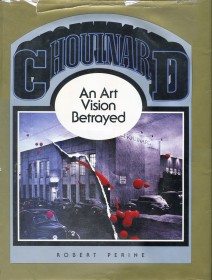 - I recently came upon an excellent book, Chouinard/An Art Vision Betrayed by Robert Perine published in 1986. This book is the history of the school that would become CalArts.
- I recently came upon an excellent book, Chouinard/An Art Vision Betrayed by Robert Perine published in 1986. This book is the history of the school that would become CalArts.
I suspect it’s more familiar to those on the West Coast than we on the other side of the continent. Regardless, the book well documents the connection between this art school and the Disney studio, particularly in the early days.
Here we’re treated to a good history of Don Graham, who led the Disney classes for Walt during the ’30s expansion movement. We also come upon students and teachers including all the famous names: Phil Dike, Virgil Partch, Hardie Gramatky, Retta Scott, Mary and Lee Blair, Ward Kimball and many others. We’re also treated to photos and artwork by these people. We also see a clear picture of the school’s founder, Nelbert Chouinard.
I’ve pulled a couple of photos and art pieces and a couple of paragraphs from the first chapter which I thought worth sharing.
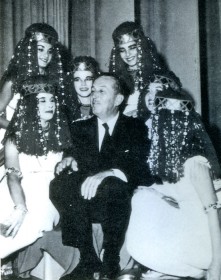 I made a deal with some of the teachers at Choulnard to come out and work with me, to sit with me by the day and know my problems. That, In turn, gave them the chance to know what we had to work on. They sat tight In the room with me; I picked Graham because he was more Life . . . figures and movement and things . . . simplification. So Graham sat with me In what we called our sweatbox. Fifty percent of my time was spent In the sweatbox going over every scene with every animator.
I made a deal with some of the teachers at Choulnard to come out and work with me, to sit with me by the day and know my problems. That, In turn, gave them the chance to know what we had to work on. They sat tight In the room with me; I picked Graham because he was more Life . . . figures and movement and things . . . simplification. So Graham sat with me In what we called our sweatbox. Fifty percent of my time was spent In the sweatbox going over every scene with every animator.
The sweatbox was an un-insulated projection room which Walt describes as “hot as the dickens,” where animators would come to sweat out Walts approval of their latest attempts. ‘They used to dread comin’ in… I’d just tear hell out of’em,” but this was all part of the learning process as both animators and studio head ____________Walt at Egyptian Ball – 1956
worked out the best solutions for making the
moving figure work. So Graham was soon a part of this process and carried Walt’s ideas back to his classroom.
Reciprocally, a bit of Graham (and Nelbert) rubbed off onto Walt as they worked together 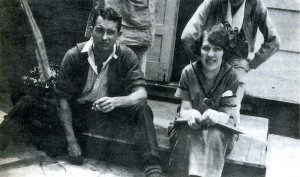 on the problems of animation. Said Walt:
on the problems of animation. Said Walt:
I set up a whole new thing (which Is) having Us effect now among the artists. We think of action. We think of drawing for action. We call It action analysis. You draw from a static figure when you’re In Life class. And your model’s sitting there. You’re draiumg the spinal column … the whole anatomy… _______Don Graham on the porch of the 8th St. School
but you don’t get any feeling of action.
So we have the model go through actions. She goes through It and then.. .sits over In the corner.. .and they sketch what they saw. What you see here (Is) not a literal copy of something. It’s.. .the Illusion you get.
Even before Walt had come to California — when he was only 19 — he had frugally photostated Muybridge’s now-famous movement photographs out of a borrowed library book, then cut them up and overlapped them in an attempt to analyze motion. But now it was a new kind of challenge — doing it with drawing. Walt further describes that challenge:
We’ve got to analyze the walk. So we would then photograph people going through actions… then we would study It. There were a lot of things I was able to get over that way. You’d have a running action. We’d draw. (It’d) be perfect because (we’d) be looking at that drawing Individually on the drawing board. (But) It doesn’t look that way; that’s what gave us stiff animation. Then we got the trick of blurting.. .In effect, elongating. When you’re moving fast Is when the action begins to take on a smoothness.. At wasn’t numbers of drawings. It’s how drawings are made.
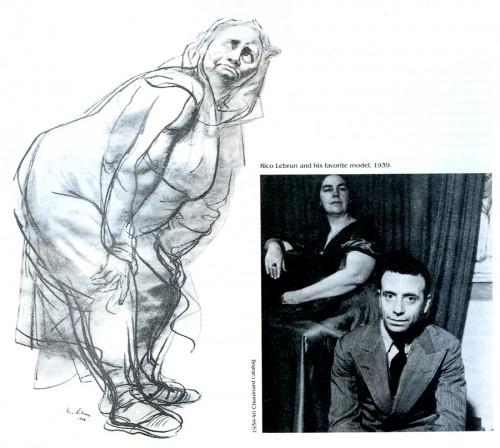
Rico LeBrun (who taught animal anatomy to the animators
at Disney during the making of Bambi) and his favorite model
-
The ideas that developed during Disney’s training period (1930-1940) were greatly aided by Don Graham. Eventually Walt hired him at Disney Studios as head of their own night school. So Nelbert’s influence and ideas were carried out into the professional world. In the animation industry alone Chouinard students and teachers like Graham, Dike, Caldwell, Davis, Gramatky, Fleury, Johnstone, Lebrun, Lee and Mary Blair, T. Hee, Plummer, and many others became important stimuli to the successful growth of the animated film.
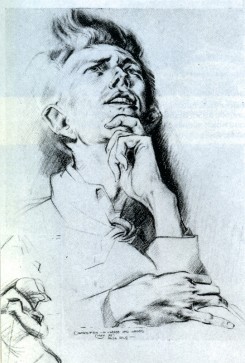
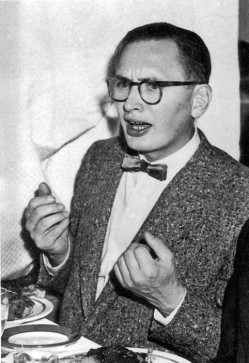
A drawing by Retta Scott | Virgil Partch at a Guild Meeting
The book is a treat. I’ll add more to this in a future post.

on 14 Apr 2009 at 9:57 am 1.Didier Ghez said …
Thanks Michael. I had not idea that this book existed and will pick it up quickly.
on 14 Apr 2009 at 10:23 am 2.Tim Rauch said …
this is a wonderful post, thanks for making it!
on 14 Apr 2009 at 10:23 am 3.David Nethery said …
So, according to the book what was the art vision that was betrayed ?
I don’t know much about the history of Chouinard’s other than the Disney connection and that the school was eventually rolled into the Cal Arts project.
Was that the betrayal ? That the school lost it’s independence and became part of Cal Arts ?
Googling turned up a bio. on author Robert Perine:
http://www.chouinardfoundation.org/robertperine
on 14 Apr 2009 at 1:51 pm 4.Dan Caylor said …
I too had no idea this book existed.
(Shameless plug)
You can download Graham’s book from my site.
on 14 Apr 2009 at 4:27 pm 5.Linda Gramatky Smith said …
I loved reading about this Chouinard book (which we do have) and seeing my dad’s name (Hardie Gramatky). My mother told me a bit more about the Disney story and I wrote it in a catalogue about Dad. You may find her rembrances interesting: “Hardie began working at the Walt Disney Studio in 1929, going to art school at night and to the Studio during the day…. In an interview, my father recalled, `In those days tehre was a very small group. We would do the story at night with Walt clowning around, acting like crazy, and in the daytime we did the animation.’ He described how exciting it was and how Walt was such a master at inspiring others. … `Working with Disney opened the world for me. Walt sat next to me and taught me animation. I think that the movement and action in my watercolors stem primarily from that early work with animation.’ During that first year, Hardie would go out and paint watercolors or sketch every day at noon. One day Walt saw him coming back to the Studio and asked, `What were you doing?’ Hardie said he was out making drawings and Walt said, `What do you do THAT for?’ Soon afterwards, [after Dad told him about Don Graham at Chouinard] Walt arranged for his animators to study drawing with Don Graham — a good artist who knew anatomy well — at Chouinard.”
on 14 Apr 2009 at 4:29 pm 6.Linda Gramatky Smith said …
Oops, no Spell Check, and of course it’s “remembrances”. LOL.
on 14 Apr 2009 at 5:24 pm 7.George Taylor said …
Thanks for the review and info, Michael!
Like Didier, I am going to add this one to my list.
on 14 Apr 2009 at 7:14 pm 8.Paul Spector said …
Hey Linda, that’s really interesting, and thanks for relating it. In 1930 when my father was only 16 he went into Disney studios at night and asked for a job! He (my dad) said there was a group of cartoonists sitting around in a conference. Maybe your dad was among them?
on 14 Apr 2009 at 8:30 pm 9.Bill Perkins said …
Hi Michael.
I’m glad you were able to locate a copy of this book and that you are both enjoying it and that it has generated some interesting feedback. I was put onto it by Nancy Beiman during a conversation I had with her about Bill Moore – a design instructor we both had at Cal-Arts. Moore figured quite predominately in the history of Chouinard and as well influenced entire generations of artists and animators. I had the great good fortune the correspond with Bob Perine as well meet him at a social function – a fund raiser in 2003 for the Chouinard Foundation, a non profit school of art founded in order to “revive the legacy and ideals of Chouinard as an eclectic, relevant institution” that I understand runs to this day independent of Cal Arts. The fund raiser was held at the Nelbert Chouinard’s former home in south Pasadena, and I spent the evening conversing with many animation veterans both about the school as well as there careers. For an animation history buff it was quite the experience. What I found most interesting was how persuasive the schools influence was is so many west coast based visual arts fields from its founding till its closing. Animators, Set Designers, Costume designers, people that started at Disney’s and went on to be successful illustrators, cartoonists etc. It is truly an interesting read and important history.
on 15 Apr 2009 at 7:43 am 10.Michael said …
Thanks for the recommendation, Bill. There’s a lot in there.
on 29 Sep 2009 at 2:15 am 11.MargaretThompson Arial said …
Thanks for this !we are fast becoming an extinct tribe.i graduated in June 1969 Margaret Thompson Arial
email me Artistinsc@aol.com